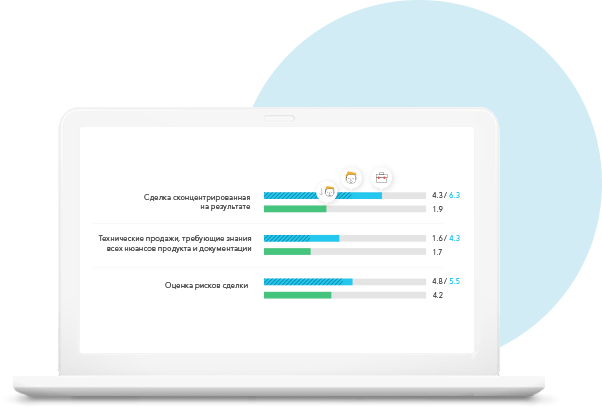DISC Job Profile
(Benchmarking)
We see our task as implementing a technology that helps objectively, accurately and affordably draw up special requirements for the position taking into account the unique nature of your organization. This means creating the most important criteria for further personnel decisions.

Steps to counter erroneous stereotypes
To increase objectivity:
-
A description of the position using DISC method is made by several specialists in a particular company familiar with its unique features.
-
Only unique patterns created for your organization are used providing a solid basis for success in hiring, induction and coaching.
-
Excludes the use of generalized, universal templates
Job Profile report
(JP DISC) explores:
-
Core competencies
-
Motivating and demotivating environment
-
Up to 200 job competencies. You choose which parameters to measure

About the recruitment process
When we create a Job Profile, we define clear CRITERIA, what is required of applicants for it. Assessing current employees or applicants for a vacant position according to the DISC method in its entirety, understanding how it will function, what are its strengths, limiters, motivators, any thinking employer will still ask himself the question:
The presence of such competencies as: leadership, ambition or initiative doesn't necessarily makes it optimal for solving specific tasks that require perseverance, caution, diligence, stress tolerance, attention to detail, commitment, punctuality.
The converse is also valid.
So, with what are our real expectations from employees?
What kind of employee do we really need?

the competencies of this person?
What is the standard?
The task defines everthing
Ask yourself, how does a real leader with an active life position behave? How long can they be effective? How does a system administrator or
What are the prospects for a design engineer in the role of a salesperson?
The answer to a question is defined not by the title of this or that position, but the point or requirements of it.
Moreover, these requirements can vary significantly from company to company!
A job with the same title
can have a range of different meanings
in the minds of different employers.
Misconceptions in hiring:
-
1
Managers select people similar to themselves.
-
2
The best employees are active ambitious independent people, preferably with leadership qualities.
-
3
All you need to do to select a good employee is to study their resume and references.
-
4
I need an employee who is able to make decisions, is sociable,
stress-resistant , punctual and efficient. -
5
Employees focused on performance, those who ignore management or do not know how to sell their ideas are not effective. They should be disposed of.
-
6
If an employee is underdeveloped in some areas, such as communication skills, analytical skills, independence and punctuality, it does not matter, as they will learn in practice. The main thing is having the required knowledge.
-
7
Conflict increases competition in nbsp;a nbsp;company, which in nbsp;turn improves performance.
-
8
The best motivators are promotion, salary increase, or vice versa, to use negative motivators of intimidation and pressure.
Want to do the right thing?
Use INSUNRISE
®
professional tools
Contact our experts for advice or access
to a free
DISC Job
Profile Tool
working areas
Research in recent decades shows that talent is one of the most undervalued corporate assets. People are too often hired or promoted based on a subjective sense of «I think this is the right person», rather than on an objective assessment of their competencies and attitudes to certain issues.

Experience in identifying talent clearly shows that:
-
Employee appraisal saves and makes money. The cost of hiring inefficient employees is very high, but often goes untold. Even for
low-level positions, unsuccessful recruitment results in a minimum of double salary for the employee, not to mention other temporary losses. When hiring for higher positions, costs may exceed the salary astronomically. -
Hiring the right person for the right job maximizes profitability. «Busy» employees show significantly higher productivity and morale.
This is very important because the level of customer satisfaction and loyalty is directly related to the level of employee satisfaction and involvement. -
Staff retention is equivalent to the saving of monetary assets. Employees remain employed and are more loyal to those organizations that offer opportunities for development, which is extremely important for their stability, career and advancement.
-
All this speaks in favor of return on investment in staff appraisal and head hunting. For example, a popular study found that Fortune 500 companies focused on attracting and identifying talent with high-precision assessment tools earn
than their competitors.














